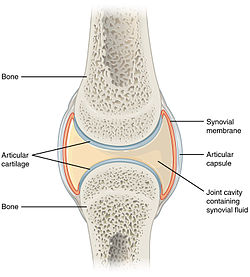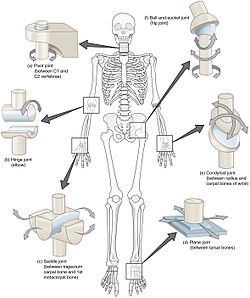Synovial joints
| Synovial joint | |
|---|---|

Structure of synovial joint
|
|

Types of synovial joints. Clockwise from top-right: Ball and socket joint, Condyloid joint, Plane joint, Saddle joint, Hinge joint and Pivot joint.
|
|
| Details | |
| Identifiers | |
| Latin | junctura synovialis |
| TA | A03.0.00.020 |
| FMA | 7501 |
|
Anatomical terminology
[]
|
|
A synovial joint, also known as diarthrosis, joins bones with a fibrous joint capsule that is continuous with the periosteum of the joined bones, constitutes the outer boundary of a synovial cavity, and surrounds the bones' articulating surfaces. The synovial cavity/joint is filled with synovial fluid. The joint capsule is made up of an outer layer, the articular capsule, which keeps the bones together structurally, and an inner layer, the synovial membrane, which seals in the synovial fluid.
They are the most common and most movable type of joint in the body of a mammal. As with most other joints, synovial joints achieve movement at the point of contact of the articulating bones.
Synovial joints contain the following structures:
Many, but not all, synovial joints also contain additional structures:
The bone surrounding the joint on the proximal side is sometimes called the plafond, especially in the talocrural joint. A damage to this occurs in a Gosselin fracture.
The blood supply of a synovial joint is derived from the arteries sharing in the anastomosis around the joint.
There are six types of synovial joints. Some are relatively immobile, but are more stable. Others have multiple degrees of freedom, but at the expense of greater risk of injury. In ascending order of mobility, they are:
"universal Joint"
The movements possible with synovial joints are:
...
Wikipedia
